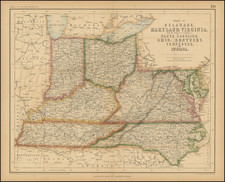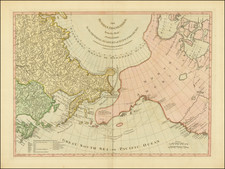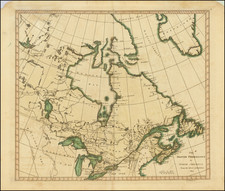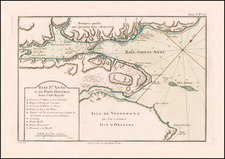Attractive example of John Speed's map of the Northeastern US and part of Canada, extending from the St Louis and Quebec in the Northeast to the Chesapeake and Deleware Bays in the South. This map based upon Jansson's 1651 Belgii Novi…, the most influential map of the region published in the second half of the 17th Century. One of the notable distinctions is tha the map provides English names for several early towns, including New London, Barnstable, New Castl and Boston. The map includes well over 100 place names along the Atlantic coast and inland along the Connecktecut River to Mr Pinser's House, the Hudson to just beyond Fort Orange, and the Indian Villages up the Delaware and Sasquahana Rivers. Nantucket and Martha's Vinyard are shown and and named, as is Block Island. Long Island has over a dozen placenames on the isalnd. The map is further embellished by a number of indigenous animals and birds roaming the interior. Includes a decorative cartouche, 2 compass roses and a decorative scale of miles. The text on the verso povides an interesting look into the Colonies shortly after the English retook control. Minor reinforcements to one or two marginal tears, else a nice example of this hard to obtain map.
John Speed (1551 or '52 - 28 July 1629) was the best known English mapmaker of the Stuart period. Speed came to mapmaking late in life, producing his first maps in the 1590s and entering the trade in earnest when he was almost 60 years old.
John Speed's fame, which continues to this day, lies with two atlases, The Theatre of the Empire of Great Britaine (first published 1612), and the Prospect of the Most Famous Parts of the World (1627). While The Theatre ... started as solely a county atlas, it grew into an impressive world atlas with the inclusion of the Prospect in 1627. The plates for the atlas passed through many hands in the 17th century, and the book finally reached its apotheosis in 1676 when it was published by Thomas Bassett and Richard Chiswell, with a number of important maps added for the first time.











![[Revolutionary War Plans of New York, Boston, Charleston, Delaware River to Philadelphia & Havana] Various Plans and Draughts of Cities, Towns, Harbours &c . . .](https://storage.googleapis.com/raremaps/img/small/83450.jpg)


![[ Temperance Allegorical View ] Black Valley Railroad. Tickets Sold at all Liquor Shops. Accidents by Collisions are Entirely Avoided, as no up Trains are Run Over the Road.](https://storage.googleapis.com/raremaps/img/small/101469.jpg)